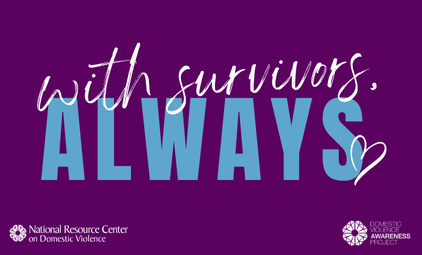Reaching Out
 Advocates working to end domestic and sexual violence have long recognized the importance of relationships. Reaching out and working with individuals, groups, and systems has been a hallmark of our social change efforts. As we move forward, we strive to enhance our programs’ accessibility, diversity, and service to traditionally marginalized communities. And we deepen our understanding of the importance of fostering relationships with collaborative partners outside of the sexual and domestic violence field. Resources highlighted in this eNewsletter offer strategies for effective relationship building to reach a variety of underserved communities and strengthen our partnerships with those who work towards similar goals: peace, equality, and justice.
Advocates working to end domestic and sexual violence have long recognized the importance of relationships. Reaching out and working with individuals, groups, and systems has been a hallmark of our social change efforts. As we move forward, we strive to enhance our programs’ accessibility, diversity, and service to traditionally marginalized communities. And we deepen our understanding of the importance of fostering relationships with collaborative partners outside of the sexual and domestic violence field. Resources highlighted in this eNewsletter offer strategies for effective relationship building to reach a variety of underserved communities and strengthen our partnerships with those who work towards similar goals: peace, equality, and justice.
SERVING LGBTQ COMMUNITIES

Preventing and Responding to Domestic Violence in Lesbian, Gay, Bisexual, Transgender, or Queer (LGBTQ) Communities by the Minnesota Center Against Violence and Abuse in partnership with the National Resource Center on Domestic Violence (July 2013)
The select resources and research in this Special Collection illustrate the LGBTQ communities’ experiences with domestic violence within the U.S. Resources especially relevant to these individuals, as well as straight allies and professionals, address the issue of domestic violence in LGBTQ communities, relationships, and the impact on society. Guidance for enhancing culturally specific practice and policy initiatives is provided.
CREATING PARTNERSHIPS WITH COMMUNITIES OF FAITH

Domestic Violence and Religion by the National Resource Center on Domestic Violence (June 2013)
This special collection outlines how faith leaders from many different spiritual communities can become effective allies in the prevention and intervention of domestic violence in their communities. It can also serve as an important tool for secular domestic and sexual violence advocates to 1) understand the important role that faith and religious practice may play in the lives of survivors, 2) learn how to build collaborations with leaders in various faith traditions, and 3) explore ways that programs can better support the spiritual needs of families that experience abuse.
ADDRESSING ABUSE IN LATER LIFE
 Preventing and Responding to Domestic & Sexual Violence in Later Life by the National Clearinghouse on Abuse in Later Life (NCALL) in collaboration with the National Resource Center on Domestic Violence (NRCDV) for VAWnet, the National Online Resource Center on Violence Against Women (Updated June 2013)
Preventing and Responding to Domestic & Sexual Violence in Later Life by the National Clearinghouse on Abuse in Later Life (NCALL) in collaboration with the National Resource Center on Domestic Violence (NRCDV) for VAWnet, the National Online Resource Center on Violence Against Women (Updated June 2013)
By focusing specifically on domestic and sexual violence (DV/SV) in later life, this special collection highlights the complexities of older people’s experiences of domestic and sexual violence and emphasizes collaborative and multi-pronged approaches to addressing domestic and sexual violence in later life. Accordingly, the materials included in this special collection have been organized by their relevance to key stakeholders.
SERVING SURVIVORS WITH PETS

Sheltering Animals and Families Together (SAF-T) helps bring greater awareness to the linkage between the urgent need to protect domestic violence victims and their pets from further abuse, and about the comfort that pets can provide, especially in times of stress and trauma. When a family violence shelter is unable to help a family with pets, they are missing an opportunity to help a large segment of their community and end the cycle of violence. With over 60 shelters participating, greater awareness and implementation of SAF-T is needed to help more families (access the 2012 Start-Up Manual).
Many shelters across the country have hosted National SAF-T Day events in their communities to raise funds to start their onsite pet housing program. Shelters can register now for the October 5th Annual National SAF-T Day; registration is open until August 26th. Read about the National SAF-T Day Campaign for details on how to organize an event for your shelter or program. Eligible shelters include those that house pets onsite, offsite or that want to start their own program. For questions related to starting SAF-T and to register for National SAF-T Day, please contact Allie Phillips, SAF-T Founder.
BUILDING A WORLD WE WANT TO LIVE IN

The California Coalition Against Sexual Assault (CALCASA) is proud to host the 2013 National Sexual Assault Conference in Los Angeles, California, in partnership with the Pennsylvania Coalition Against Rape (PCAR) and the National Sexual Violence Resource Center (NSVRC).
This year’s conference theme, Inspire a Movement, Invest in Change, Imagine…, will focus on providing cutting-edge information, effective and relevant practices, content that incorporates culturally appropriate outreach and services to historically underserved communities and those with limited access – all aimed at demonstrating how we can build the world we want to live in.
SHARING PREVENTION RESOURCES
 The Intimate Partner Violence Prevention Council (IPVPC) envisions a future in which a multitude of agencies and organizations at the local, state, territory, tribal and national levels are engaged in collaborative and sustained primary prevention activities leading to social change that addresses the root causes of intimate partner violence in our culture. To that end, one of our primary strategies is to develop a web-based repository of prevention resources and packages of adaptable models and tools to support primary prevention work.
The Intimate Partner Violence Prevention Council (IPVPC) envisions a future in which a multitude of agencies and organizations at the local, state, territory, tribal and national levels are engaged in collaborative and sustained primary prevention activities leading to social change that addresses the root causes of intimate partner violence in our culture. To that end, one of our primary strategies is to develop a web-based repository of prevention resources and packages of adaptable models and tools to support primary prevention work.
We have received posters, campaign guidebooks, workshop outlines, research projects, educational courses/curricula, assessment tools, and organizational models for capacity building from across the US and internationally. We hope that you won’t miss this opportunity to share your innovative prevention materials with the field.

Please pass this invitation along and submit your own materials today. Thanks so much for your help in building this new valuable online resource exchange!
PREPARING FOR DVAM 2013
 Domestic Violence Awareness Month (DVAM) 2013 is just around the corner. Be sure to visit the Domestic Violence Awareness Project (DVAP) website for helpful resources to help plan your events and initiatives over the next three months. Here you’ll find campaign ideas, artwork, training resources, promotional materials, and other inspiration for promoting social change during the month of October and throughout the year.
Domestic Violence Awareness Month (DVAM) 2013 is just around the corner. Be sure to visit the Domestic Violence Awareness Project (DVAP) website for helpful resources to help plan your events and initiatives over the next three months. Here you’ll find campaign ideas, artwork, training resources, promotional materials, and other inspiration for promoting social change during the month of October and throughout the year.
Be sure to connect with us via the NRCDV’s various social media channels: you can follow and engage with the National DVAP on Tumblr, Twitter, and Instagram today!
ACCESSING REGIONAL FUNDING OPPORTUNITIES
The National Resource Center on Domestic Violence is pleased to offer a Regional Funding Alert in addition to the traditional Funding Alert, reporting current state/regional funding opportunities focusing on domestic violence, victim services and related issues by U.S. Region. Subscribe today or update/change your preferences to include your region(s) of interest.
TA QUESTIONS OF THE MONTH
Read and comment on these recent requests received by the National Sexual Violence Resource Center and National Resource Center on Domestic Violence!
No woman should ever be forced to choose between safety and her religious community or tradition. She should be able to access the resources of both community-based advocacy and shelter and faith-based support and counsel. For her to do so, she needs these two resources to work collaboratively so that they can provide consistent advocacy and support for victims and survivors and participate in the process of holding perpetrators accountable. (Fortune & Enger, 2005)
June 2013: What is the connection between sexting and sexual violence?
The rate of youth exposure to sexting highlights a need to provide them with information about legal consequences of sexting and advice about what to do if they receive a sexting image. However, the data suggest that appearing in, creating, or receiving sexual images is far from being a normative behavior for youth. (Mitchell & Finkelhor, 2012)
May 2013: How can I help elders in my community be safe from abuse?
Although research on the incidence and prevalence of elder abuse is still very limited, it is estimated that as much as 11% of US elders report experiencing some type of abuse or neglect. Older victims may be abused by intimate partners, adult children, grandchildren or other family members, caregivers or others in positions of authority. In a majority of cases, the perpetrator is the victim’s family member, most often an intimate partner (Acierno et al., 2009; Lifespan of Greater Rochester, 2011)
RECENT ADDITIONS
View all recent additions to the VAWnet library. Highlights include:
Global and regional estimates of violence against women: Prevalence and health effects of intimate partner violence and non-partner sexual violence by the World Health Organization (2013)
Preventing sexual violence in Latin@ communities: A national needs assessment by the National Sexual Violence Resource Center (2013)
Essentials for Childhood: Steps to Create Safe, Stable, and Nuturing Relationships by the Centers for Disease Control and Prevention, National Center for Injury Prevention and Control (2013)
International Anti-Street Harassment Week 2013 Report by Holly Kearl for Stop Street Harassment (2013)
Sexual Victimization in Prisons and Jails Reported by Inmates, 2011-12 by Allen J. Beck, Marcus Berzofsky, Rachel Caspar, and Christopher Krebs for the U.S. Department of Justice, Bureau of Justice Statistics (May 2013)
Report of the Special Rapporteur on violence against women, its causes and consequences by Rashida Manjoo for the United Nations General Assembly (May 14, 2013)
Toward Healthy and Whole: Rethinking Gender and Transformation for Bois of Color by The Brown Boi Project (2012)
Addressing Discriminatory Housing Barriers for Victims of Domestic Violence: A Toolkit for Advocates by the Pennsylvania Coalition Against Domestic Violence (2013)
Healthy Native Families: Preventing Violence At All Ages 2nd Edition by MM Kemberling and LD Avellaneda-Cruz for the Alaska Native Tribal Health Consortium, Alaska Native Epidemiology Center (March 2013)
















